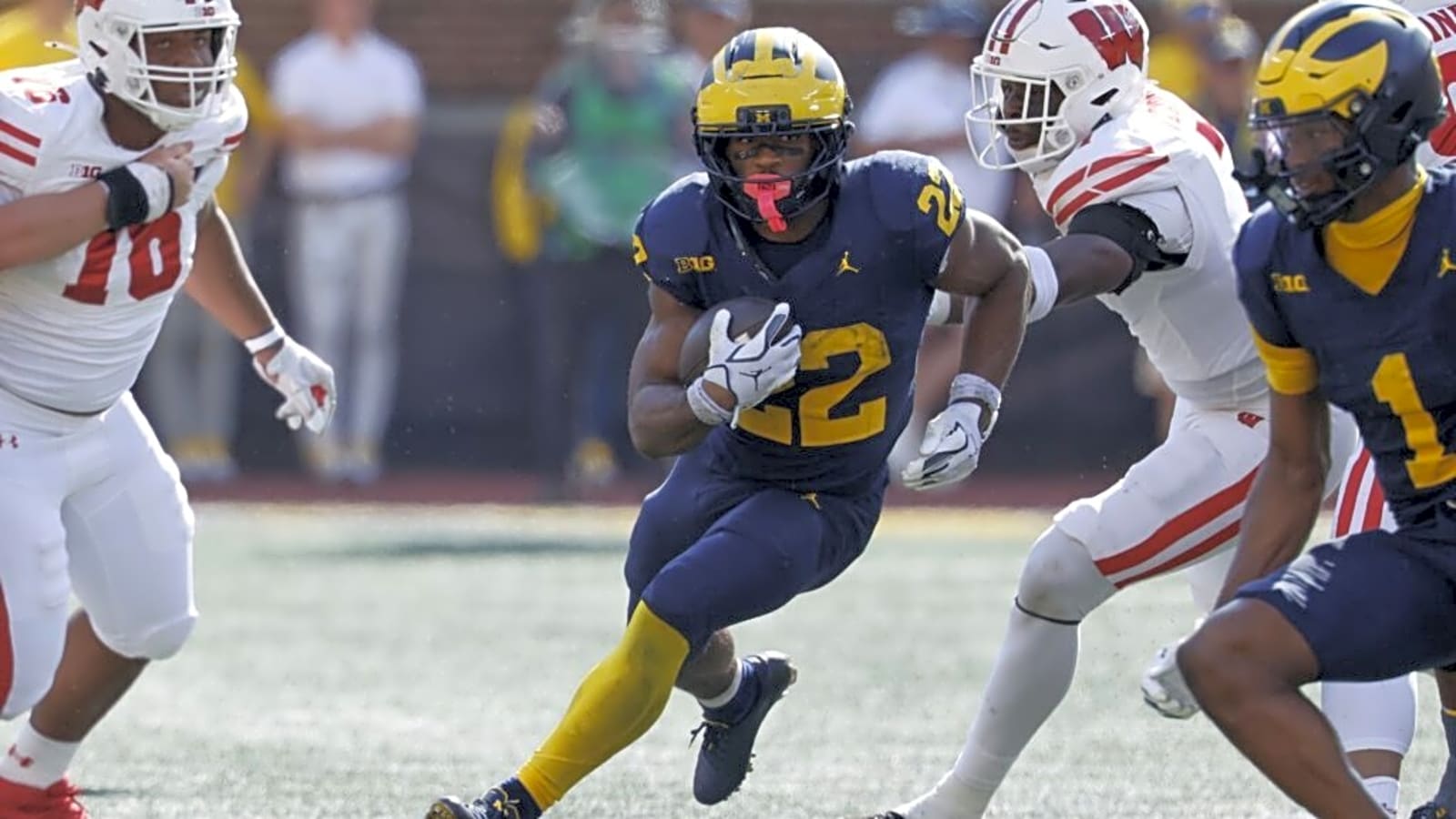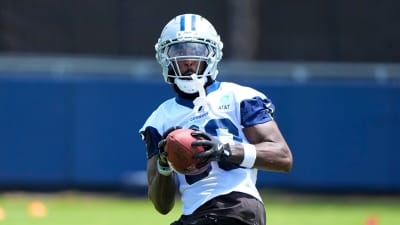
The Michigan football team demonstrated growth during its dominant victory over Wisconsin, as evidenced by its position-by-position performance evaluation.
The Wolverines demonstrated their growth with a dominant 34-17 victory against Wisconsin, which was televised nationally. The Michigan vs Wisconsin game showcased both strengths and weaknesses, although the Wolverines ultimately emerged victorious. The game began with an unbalanced first quarter, but Michigan established dominance through Underwood’s calm leadership and defensive pressure, which disrupted Wisconsin’s attacking flow.
Each victory in sports reveals essential lessons about the team. The Michigan vs Wisconsin matchup showcased both strengths and weaknesses, although the Wolverines ultimately emerged victorious. The Wolverines achieved their fourth victory of 2025 through the following unit performance assessment.
Quarterback: Grade A- | Bryce Underwood Leads Michigan vs Wisconsin Victory
Bryce Underwood has confirmed his arrival as a football player. The true freshman completed 19 of 28 passes for two hundred seventy yards and one touchdown while achieving a 67.1 quarterback rating without any interceptions. Underwood demonstrated his dual-threat ability by running for twelve yards while converting two crucial third-down plays with his feet.
Underwood remained calm when Wisconsin used edge pressure and disguised coverage schemes. Underwood displayed exceptional patience, accuracy, and self-assurance through his thirty-three-yard pass to Donaven McCulley during the second quarter.
The quarterback demonstrated leadership qualities throughout his game, albeit with occasional mistakes, including throwing an incomplete pass and making some rushed throws. The young quarterback demonstrates an unexpected fast learning curve in understanding Chip Lindsey‘s offensive system.
Running Backs: Grade A-
Justice Haynes established the game’s tempo through his performance as the team’s running back. The Alabama transfer, Justice Haynes, delivered the necessary power to Michigan by running 19 times for 117 yards at 6.2 yards per carry while scoring two touchdowns. The 43-yard run by Haynes through the middle of the defense both changed field position and exhausted Wisconsin’s defensive energy.
Running back Jordan Marshall supported Haynes by gaining 44 yards through nine carries. The running back executed his reads well to find openings and blocked a blitzing defender, which allowed Underwood to complete a deep pass.
The most notable aspect of their performance was their ability to wait for blocking schemes to develop before making explosive runs through contact. The team achieved 5.1 yards per carry while Wisconsin struggled to maintain a secure defensive box alignment. The only negative aspect was that the Badgers managed to block the middle zone during early downs.
Wide Receivers and Tight Ends: Grade B+
The aerial plays of Donaven McCulley and Andrew Marsh produced numerous exciting moments for the Wolverines. McCulley led the team with six receptions for 112 yards and a touchdown while using his tall stature to outmuscle defenders for contested ball grabs. The 33-yard touchdown reception showcased his ability to maintain body control while demonstrating focused concentration and powerful receiving skills.
The connection between Underwood and Marsh developed through their four receptions, which yielded 80 yards, including a sideline grab. Semaj Morgan operated underneath routes, producing five receptions for forty-four yards, while his thirteen-yard punt return established Michigan with advantageous field position.
The tight ends received limited targets during the game, but their blocking performance improved after the first half. The team struggled with dropped passes throughout the game.
Offensive Line: Grade C
The team’s statistical performance did not align with the visual assessment from the game. The offensive line struggled to find stability throughout the game despite Michigan producing 445 total yards. The Wisconsin front seven started the game by penetrating early, which forced Underwood to leave his position and Haynes to run multiple plays outside the tackles.
The right side of the line experienced better pass protection, but Wisconsin defenders still managed to generate numerous pressures. Underwood’s ability to move around the field prevented several potential sack situations from becoming actual sacks.
The collective communication and team coordination have not reached complete alignment. There is a struggle with identifying stunt plays and delayed blitzes. The team needs its offensive line to become a dominant physical force that wins primary November contests.
Defensive Line: Grade B
The defensive front of Michigan maintained control in Saturday’s game, despite the statistics showing otherwise. The Wisconsin offense managed to gain only seventy-five yards through 28 rushing attempts while averaging 2.7 yards per carry.
Derrick Moore led the defense with five tackles, one sack, and one-and-a-half tackles for loss. The defensive edge penetration by Moore forced Wisconsin quarterback Hunter Simmons to attempt passes while being flushed from the pocket.
The defensive line of Kenneth Grant and Rayshaun Benny blocked running lanes, which enabled linebackers to reach the ball quickly. Enow Etta brought high energy to the game, making two tackles while consistently creating defensive pressure.
Wisconsin lost its offensive flow after Michigan implemented defensive adjustments. The defensive line at Michigan is delivering physical defense through disciplined execution.
Linebackers: Grade B-
The unit struggled in the first half due to their aggressive play and missed tackles, but it their performance improved throughout the game. The Wolverines’ defense received their best performance from Jimmy Rolder, who recorded seven total tackles and five solo stops. The defensive play of Ernest Hausmann and Cole Sullivan restricted Wisconsin’s ability to cut back through the defense.
The team faces ongoing challenges with maintaining proper gap control. The Badgers utilized their motion and misdirection to create initial running opportunities, but Michigan established defensive stability, which led to improved linebacker performance.
Secondary: Grade B+
Rod Moore intercepted a pass from Simmons during the second quarter, which completely shifted the game’s direction. Moore read Simmons’ eyes perfectly before he jumped the route to create a short field for Michigan’s offense. The defensive backfield of Zeke Berry and Jayden Sanders produced three pass deflections while their communication improved throughout the game.
The safeties demonstrated improved ability to handle play-action fakes, and the coverage rotation operated without errors throughout the game.
The secondary maintains its status as a deep and mature unit, which creates scoring opportunities through its playmaking ability. The defensive unit restricted all deep passing attempts beyond the short zone while allowing opponents to complete passes in the underneath areas.
Special Teams: Grade C+
Dominic Zvada succeeded in his first field goal attempt from 40 yards but failed his second attempt while converting all three of his extra point attempts. The crowd reacted negatively to Zvada’s thirty-five-yard field goal attempt, which sailed wide, but he showed no signs of losing confidence.
Hudson Hollenbeck delivered an outstanding performance, punting four times that resulted in 197 total yards at an average of 49.3 yards per punt. The punter successfully pinned Wisconsin inside their twenty-yard line twice during the game. His fifty-seven-yard bomb in the third quarter flipped the field entirely.
Semaj Morgan brought back a punt for 13 yards while Channing Goodwin handled a kick return for three yards. The special teams unit maintains its fundamental stability, yet needs to improve its consistency, especially in kicking operations.
Coaching: Grade B-
Head coach Sherrone Moore had some late first-half clock management decisions that were surprising. The Michigan team missed an opportunity to score additional points because they failed to call a timeout before halftime.
Offensive coordinator Chip Lindsey made effective halftime adjustments. The Wolverines started by extending their plays across the width before targeting deep passing routes, which Wisconsin defenders struggled to defend. Defensive coordinator Wink Martindale employed a basic defensive approach characterized by solid coverage and controlled rush patterns, yielding successful results.
The coaching staff executed essential corrections during this game, which proved to be the right decisions. The team needs to improve its initial performance to minimize the need for post-game adjustments.
Final Thoughts: Michigan vs Wisconsin Shows Growth and Grit
The Wolverines secured a 34-17 victory against Wisconsin, while demonstrating growth. The team started slowly, but their key players stepped up during crucial moments.
Underwood demonstrated his potential to become a defining quarterback for the program. Haynes and Marshall have shown that the running back duo can propel the team through the entire conference schedule. The defense displayed the type of discipline that makes it a top 20 unit in the country, despite occasional mistakes.
The Michigan vs Wisconsin game revealed how far this team has come and how much potential remains.
More must-reads:
- Colorado facing questions amid Deion Sanders' health concerns
- Brian Kelly provides big update on LSU QB Garrett Nussmeier
- The 'Passing leaders by NFL team' quiz
Breaking News
Trending News
Customize Your Newsletter
 +
+
Get the latest news and rumors, customized to your favorite sports and teams. Emailed daily. Always free!








